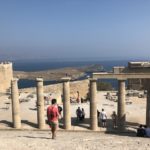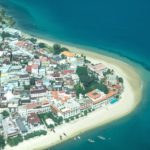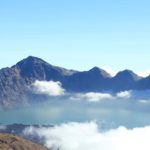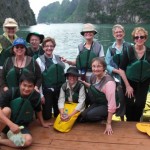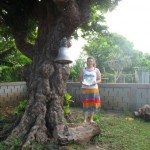Koh Panyee: The Thai Village That Floats
A village at sea rises up out of the waters, a gypsy kingdom. Its feet never touch the ground. The day I turned thirty-two I reached it, as an unexpected visitor from a faraway land.
The spirit and the history Panyee’s villagers is inspiring. An inscribed stone at the entrance to the markets tells their story: the people are descendants of an Indonesian seafaring family who sought a place to call home over 200 years ago. At the time, Thailand had laws barring them from purchasing land, so the family found a place to live in peace amongst the karsts of the sea whose waters belong to no one. There they have lived for two centuries and continue to live peacefully, their days filled with sun and rain, soccer and fish, wood and water.
I had always wanted to see the ocean karsts of Thailand, those looming limestone forms and pillars piercing the aqua ocean covered in a layer of persistent green trees that look like moss from afar. On the morning of my birthday, we made our way to Phang Na Bay and haggled to take a colorful longtail boat out. The end of June meant monsoon season with the clouds ready to burst with rain, yet the sun shone down.
We drifted through the arch and I watched the karsts from my imagination emerge all around me.
The bay was spotted with longtails, their bright yellows and pinks, greens and oranges vibrant against the horizon slowly turning grey. And then the rain poured. Droplets dimpled the bay and boats began churning by as they headed back to harbor. A wooden dugout boat with a leak went by at high speed, an elderly couple filling buckets from the floorboards and dumping them out into the bay as their boat began to sink.
We tucked into a natural arch in a karst and spent a few moments watching the silhouettes of other longtails at the far entrance emerge as the rain began to cease. As so often monsoon season rains do, they came fiercely and left quickly. The sun slid from behind the clouds again.
We drifted through the arch and I watched the karsts from my imagination emerge all around me. They were varied shapes and sizes, some with rounded domes, some erect and vertical, jagged and smooth, all carpeted in a fauna that reached its roots down through their veins and drank from the sea.
Of all the temples I would see in Asia, the karsts were somehow even more sacred. We passed by dramatic islands and continued out into the ocean. Just as I thought it may be a figment, I saw a golden dome shimmer up from the horizon line, reminiscent of the rising sun. And then I saw the giant karst it was emerging from, then green roofs and then the stilts and rafts of a village floating there before me, unattached to any land anywhere, an entire community on the water.
Koh Panyee is not a part of any landmass. It is not a town on stilts that reach into the dirt shores. It is an inhabited island of wood that floats in the middle of the sea resting just below a giant karst cliff. The only part of Panyee that rests on a piece of the karst’s limestone is their temple, the golden dome I had seen rise from the sea.
Perhaps most sentimental to me about Panyee was my experience wandering out through the school yard, and discovering the floating soccer field.
We pulled up alongside a handful of other longtails and debarked onto a steep, slick plankway connected to the floating docks. Down narrow alleyways built upon the docks, there is a marketplace where I purchased a set of hollowcups carved of dark coconut wood. A tiny wooden cafe stands in the center of the maze-like market, and the aroma of fish hovers.
At most of the stalls you can buy fish fresh from the surrounding sea, and fishing is the major livelihood. However I was, and forever will be, in awe of the agricultural techniques of the people. The floating homes outside the marketplace harnessed a hanging form of farming that I have never seen before or since. Rigged up amongst the piles and dangling from the precarious planks of the walkways that connect the homes are intricate hydroponic systems that utilize basic items and remove from the equation the one staple of agriculture missing on Panyee: soil.
Perhaps most sentimental to me about Panyee was my experience wandering out through the school yard, and discovering the floating soccer field. It was something from a dream that I never had, but as soon as I saw it I knew that sometimes life was even more vibrant than any dream. There in the middle of the sea, removed from any land, floating of its own accord backed by a hazy view of karsts with a golden temple rising up from the ocean above it was a field of dreams alive.
This stirs me both because of the ingenuity, as well as because I played competitive soccer for much of my young life. The sport is overlooked in my country, but I love it all the same and I imagined the joy and love of it that I could palpably feel on Panyee connecting me to it. Because the design of the village is based on necessity, I found it most moving that this sport was considered important enough to garner to be included as a solo vessel of joy anchored at sea, built from scrapwood and daydreams.
On Panyee, there is also a floating school with lilac walls. On it is stenciled this phrase: “Although we are far apart we are still under the same sky.”
Koh Panyee: The Thai Village That Floats

